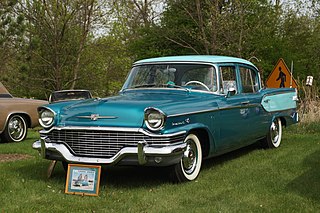
Knute Kenneth Rockne was an American football player and coach at the University of Notre Dame. Leading Notre Dame for 13 seasons, Rockne accumulated over 100 wins and three national championships.

Packard was an American luxury automobile company located in Detroit, Michigan. The first Packard automobiles were produced in 1899, and the last Packards were built in South Bend, Indiana in 1958.

Studebaker was an American wagon and automobile manufacturer based in South Bend, Indiana, with a building at 1600 Broadway, Times Square, Midtown Manhattan, New York City. Founded in 1852 and incorporated in 1868 as the Studebaker Brothers Manufacturing Company, the firm was originally a coachbuilder, manufacturing wagons, buggies, carriages and harnesses.

Kaiser Motors Corporation made automobiles at Willow Run, Michigan, United States, from 1945 until 1953. In 1953, Kaiser merged with Willys-Overland to form Willys Motors Incorporated, moving its production operations to the Willys plant at Toledo, Ohio, where the company continued to build automobiles under the Kaiser marque including the Kaiser Darrin until 1955. Their South American operations continued to build passenger cars well up into the 1960s. The company changed its name to Kaiser Jeep Corporation in 1963.

The E-M-F Company was an early American automobile manufacturer that produced automobiles from 1909 to 1912. The name E-M-F was gleaned from the initials of the three company founders: Barney Everitt, William Metzger, and Walter Flanders.

The Studebaker Commander is the model name of several automobiles produced by the Studebaker Corporation of South Bend, Indiana and Studebaker of Canada Ltd of Walkerville and, later, Hamilton, Ontario (Canada). Studebaker began using the Commander name in 1927 and, with interruptions in 1936 and 1959-63, continued to use it until 1964. The name was applied to various products in the company's line-up from year to year. The Commander was the company's mainstream product, the Studebaker Champion was the junior model, and other models were short lived or renamed as market conditions required.

The Studebaker Champion is an automobile which was produced by the Studebaker Corporation of South Bend, Indiana, from the beginning of the 1939 model year until 1958. It was a full-size car in its first three generations and a mid-size car in its fourth and fifth generation models, serving as the junior model to the Commander.

The Studebaker Dictator is an automobile produced by the Studebaker Corporation of South Bend, Indiana, United States from 1927 until 1937. Model year 1928 was the first full year of Dictator production.

The Studebaker President was the premier automobile model manufactured by the Studebaker Corporation of South Bend, Indiana (US) from 1926 until 1942. The nameplate was reintroduced in 1955 and used until the end of the 1958 model when the name was retired.

Studebaker of Canada Ltd. was the name given to Studebaker Corporation's Canadian manufacturing arm.
The Studebaker-Packard Corporation is the entity created in 1954 by the purchase of the Studebaker Corporation of South Bend, Indiana, by the Packard Motor Car Company of Detroit, Michigan. While Studebaker was the larger of the two companies, Packard's balance sheet and executive team were stronger than that of the South Bend company.

The Erskine was an American automobile brand produced by the Studebaker Corporation of South Bend, Indiana, United States, from 1926 to 1930. The marque was named after Albert Russel Erskine (1871–1933), Studebaker's president at the time.

Studebaker-Garford was an automobile produced and distributed jointly by the Garford Company of Elyria, Ohio, and the Studebaker Corporation of South Bend, Indiana, from 1904 through 1911. During its production, the car was sold as a Studebaker, per the marketing agreement between the two firms, but Studebaker collectors break the vehicles out under the Studebaker-Garford name because of the extent of Garford components.
Albert Russel Erskine was an American businessman. Born in Huntsville, Alabama, he worked in a number of manufacturing industries before joining the Studebaker motor car manufacturing firm in 1911. He served as Studebaker's president from 1915 until the firm encountered severe financial problems in 1933, when he committed suicide.

Harold Sines Vance was an American automobile company executive and government official, notable for being chairman (1935–54) and president (1948-54) of the Studebaker Corporation and for a four-year term on the Atomic Energy Commission, where he encouraged the industrial use of nuclear energy.

The Piquette Avenue Industrial Historic District is a historic district located along Piquette Street in Detroit, Michigan, from Woodward Avenue on the west to Hastings Street on the east. The district extends approximately one block south of Piquette to Harper, and one block north to the Grand Trunk Western Railroad Line. It was listed on the National Register of Historic Places in 2004.
Delmar Gerle "Barney" Roos was an American automotive engineer who served as Studebaker's head of engineering from 1926 to 1936, specialising in straight-eight engines. He later worked for the British Rootes Group in the design of Humber, Hillman and Sunbeam Talbot cars. Before World War II, he returned to the United States, where he co-designed the Willys MB, the original Jeep.

Willys was a brand name used by Willys–Overland Motors, an American automobile company, founded by John North Willys. It was best known for its design and production of World War II era military jeeps (MBs), Willys M38 and M38A1 military jeeps as well as civilian versions, and branding the 'jeep' military slang-word into the '(Universal) Jeep' marque.
Rockne was an American automobile brand produced by the Studebaker Corporation of South Bend, Indiana, from 1932-1933.

The Three Musketeers is a nickname given to a team of three Studebaker engineers, Frederick Morrell Zeder, Owen Ray Skelton, and Carl Breer. They would become instrumental in the founding of the Chrysler Corporation, and were hand-picked by Walter Chrysler to come with him when he started the new company.

















